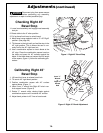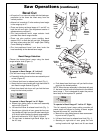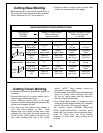
22.
Basic Saw Operations (continued)
Auxiliary Fence
Certain types of molding need a fence face extension
because of the size and position of the workpiece.
Holes are provided in the fence to attach an auxiliary
fence. The auxiliary fence is used with the saw in the
0
° bevel position only.
1. Place a piece of wood against the miter saw fence.
(Wood can have a maximum height of 4-1/2".
Check that auxiliary fence assembly does not
interfere with head assembly.)
For splinter-free cuts of molding, attach a one piece
wood auxiliary fence and then cut openings with
miter saw.
2. Mark the locations of the support holes on the
wood from the back side of the fence.
3. Drill and countersink the holes on the front of the
support board.
4. Attach (each) auxiliary fence using two (2)
3/16" flat head machine screws. With 3/4" auxiliary
fence use 1-1/2" long screws. Secure behind
metal fence with washer and machine nuts.
Alternate: With 3/4" auxiliary fence, use 1/4" round
head wood screws (3/4" long). Drill four (4) pilot
holes (smaller than 1/4”) through the auxiliary
fence and run screws through rear of metal fence.
5. Make a full depth cut to create the blade slot.
Check for interference between the auxiliary fence
and the lower blade guard. Make adjustments as
necessary.
Check for interference from any
components.
Figure: Auxiliary Fence
WARNING
!
Auxiliary
Fence
Blade Slot
Flat Head
Machine
Screws


















